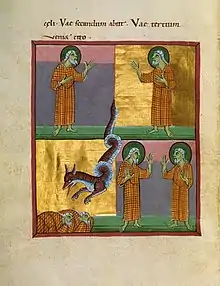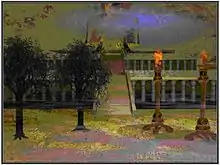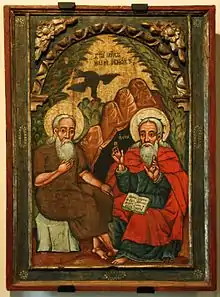
In the Book of Revelation, the two witnesses (Ancient Greek: δύο μαρτύρων, romanized: duo martyron) are two prophets who are mentioned in Revelation 11:1-14. Some Christians interpret this as two people, two groups of people, or two concepts. Some believe they are Enoch and Elijah, as in the Gospel of Nicodemus, since they are the only two that did not see death as required by the Scriptures,[1] while others believe them to be Moses and Elijah because they appeared during the transfiguration of Jesus,[2] or because Enoch was not Abraham's descendant. They have the power to shut the heavens (Elijah) and turn water into blood (Moses).
Dispensationalist Christians believe that the events described in the Book of Revelation will occur before and during the Second Coming.
Biblical narrative
And I will grant my two witnesses authority to prophesy for one thousand two hundred sixty days, wearing sackcloth.
These are the two olive trees and the two lampstands that stand before the Lord of the earth. And if anyone wants to harm them, fire pours from their mouth and consumes their foes; anyone who wants to harm them must be killed in this manner. They have authority to shut the sky, so that no rain may fall during the days of their prophesying, and they have authority over the waters to turn them into blood, and to strike the earth with every kind of plague, as often as they desire.
When they have finished their testimony, the beast that comes up from the bottomless pit will make war on them and conquer them and kill them, and their dead bodies will lie in the street of the great city that is prophetically called Sodom and Egypt, where also their Lord was crucified. For three and a half days members of the peoples and tribes and languages and nations will gaze at their dead bodies and refuse to let them be placed in a tomb; and the inhabitants of the earth will gloat over them and celebrate and exchange presents, because these two prophets had been a torment to the inhabitants of the earth.
But after the three and a half days, the breath of life from God entered them, and they stood on their feet, and those who saw them were terrified. Then they heard a loud voice from heaven saying to them, "Come up here!" And they went up to heaven in a cloud while their enemies watched them. At that moment there was a great earthquake, and a tenth of the city fell; seven thousand people were killed in the earthquake, and the rest were terrified and gave glory to the God of heaven.
Textual analysis

According to the text, the two witnesses are the "two olive trees and the two lampstands" that have the power to destroy their enemies, control the weather and cause plagues. This description may be symbolism, allegory, or literal.[4]
Exegesis
In attempting to interpret Revelation 11, commentators who hold to a premillennial eschatology generally interpret the two witnesses in one of three ways:
- as individuals either manifested in some form of reincarnation; or "in the spirit" of biblical prophets who once appeared in Bible history; or simply as two individuals newly arrived on the earth;
- as corporate in nature (human) standing for the Church only or for Israel only; or both Israel and the Church; or for both Jewish and Gentiles believers in Jesus; or
- as symbolism or an expression of biblical concepts (i.e., the Old and New Testaments; the Law and the Prophets;[5] Mercy and Grace).
The literalist typically has a dispensationalist or literal interpretation that the two witnesses will be actual people who will appear in the last days.[6][7] However, there are varying views as to their identity.
Modern theologians, such as John Walvoord, have furthered the point of individualism by comparing the "two lampstands" and the "two olive trees" of Revelation 11 to the two golden pipes and two olive trees/branches of Zechariah 4. By the identification of the two olive branches as "two anointed ones" or "two sons of the oil", in Zechariah, this reinforces the literalist interpretation that the two witnesses are two people.[8] The personification of the two witnesses in Revelation is so prevalent that according to theologian William Barclay, the passage seems to refer to definite persons.[9] Walvoord further pointed out that because the Revelation passage does not specifically identify who the two witnesses are, it would be safer to conclude that they are not related to any previous historical character.[10]
As individuals

| Christian eschatology |
|---|
| Christianity portal |
The apocryphal Gospel of Nicodemus (also known as Acts of Pilate) states that those two witnesses who will appear in times of Antichrist to engage in battle with him are Enoch and Elijah:
3One of them answering, said, I am Enoch, who was translated by the word of God: and this man who is with me, is Elijah the Tishbite, who was translated in a fiery chariot. 4Here we have hitherto been, and have not tasted death, but are now about to return at the coming of Antichrist, being armed with divine signs and miracles, to engage with him in battle, and to be slain by him at Jerusalem, and to be taken up alive again into the clouds, after 3 days and a half.
— Gospel of Nicodemus, Chapter 20:3–4
Others have proposed Moses as one of the witnesses, for his ability to turn water into blood and the power to plague the earth.[11] It is possible that one of two witnesses would be Elijah the prophet (Malachi 4:5-6) based on an interpretation of the bible verses. John the apostle (Revelation 10:11) could also be a candidate.
Early Christian writers such as Tertullian, Irenaeus, and Hippolytus of Rome, have concluded that the two witnesses would be Enoch and Elijah, the two prophets who did not die because God "took" them according to other Biblical passages.
As symbols of the church
The two witnesses have been interpreted as representing the Church or a similar concept. The 1599 Geneva Study Bible has asserted that the two witnesses are the exclusive purview of the church.[12] Matthew Henry's Complete Commentary on the Whole Bible gives one church interpretation as consisting of believing Jews and that of the gentiles.[13] John Wesley in his commentary on Revelation 11 suggests a more spiritual, almost ambiguous, application.[14] John Gill's Exposition of the Bible interprets the two witnesses as the true Church in counterdistinction to the "antichrist system" of Roman Catholicism.[15] Ross Taylor's Verse by Verse Commentary on Revelation clearly defines the Church as the "two olive trees and the two lampstands."
Similarly, the two witnesses have been identified as Israel and the Christian Church. The number two has been associated with the witness of Israel to the gentile nations during the 70th Week of Daniel's prophecy.[16] The olive tree signifies Israel. The "witness of the Church" is signified by the two lampstands, whose identity was disclosed by the seven golden lampstands (i.e., candlesticks) revealed in Revelation 2–3 as the "churches". Revelation 2:1 refers to the churches as golden lampstands.
It has also been proposed that the two witnesses are the witnessing church, because Jesus sent out his disciples "two by two".[17] The two witnesses are the true prophetic witness in Revelation (the church), and they serve as the counterpart to the false prophetic witness, the beast from the land, who has two horns like a lamb (Revelation 13:11; cf.16:13; 19:20; 20:10).
Other views
The Church of Jesus Christ of Latter-day Saints believe that the two witnesses will be two prophets who are raised up to the Jews in the modern nation of Israel,[18][19] possibly two members of their Quorum of the Twelve or their First Presidency, who are considered to be prophets by the church. These two prophets will represent both the ancient Northern and Southern kingdoms of Israel (the two olive trees) and be descendants of the two covenant sons from the tribes of Judah and Joseph (as the two lampstands). Some members have suggested that the martyrdom of Joseph Smith and his brother Hyrum Smith (Assistant President from 1841 to 1844) are prototypes and they represent the future two witnesses (stated in Revelation) who will be sent to Jerusalem and be killed for their testimonies.
In traditional Seventh-day Adventist interpretation, as found in Uriah Smith and Ellen G. White, the two witnesses are the Old and New Testaments.[20][21][22] They believed that the French Revolution was the time when the two witnesses were killed.[23][24] Other historicists also consider the two witnesses in this way.[25][26]
The Bahá'í Faith identifies the two witnesses as Muhammed, the founder of Islam, and Ali, the son of Abú Tálib. They consider Muhammad as the root and Ali the branch, comparable to Moses and Joshua. They interpret "clothed in sackcloth" to mean that they initially appeared to be of no consequence and without a new revelation because the spiritual principles of Islam would correspond closely with those promulgated in Christianity and Judaism. They identify the "beast" to be the Umayyads, who would wage spiritual war against them. The 1,260 days is interpreted as the 1,260 lunar years since the start of the Islamic calendar, corresponding to the Gregorian year 1844; the year the Millerite movement also predicted the return of Christ. The Bahá'í Faith recognizes the significance of 1844 as the year of the declaration of the Báb, bearing a new message from God and proclaiming the coming of Bahá'u'lláh, the Prophet-Founder of the Bahá'í Faith and promised return of Christ.[27][28]
Marshall Applewhite and Bonnie Nettles (Do and Ti), the leaders of the UFO religious cult Heaven's Gate, initially claimed to be the two witnesses in the 1970s. According to their interpretation, they would be killed and resurrected before ascending to heaven in a spacecraft. They ultimately rebranded their "assassinations" as symbolic rather than actual death, owing to the ridicule they were subjected to by the media.[29]
In popular culture
The two witnesses play a central role in the supernatural drama television series Sleepy Hollow. The first witness is Ichabod Crane, a Revolutionary War soldier who, after battling with the Horseman of Death (whom he causes to be headless), awakens in Sleepy Hollow in 2013. The second witness is Lieutenant Abbie Mills, a contemporary woman in law enforcement who helps Crane adjust to the 21st century and aids him in battling dæmonic forces. The two witnesses must face 'Seven Tribulations' (although other characters note that the Witnesses are only required to witness the events rather than take action themselves), the first being Moloch, the master of the Horsemen. The second Tribulation is Pandora and her master, an ancient Sumerian god known as the Hidden One. Third was Malcolm Dryfus and Jobe. Although Lieutenant Mills (now Agent Mills of the F. B. I.) loses her soul, there must always be two witnesses, and the mantle passes on to Molly Thomas on her eleventh birthday. Not long thereafter, Molly's older self, going by the name Lara, comes from the future to aid Crane in his battles, thereby assuming the mantle of the witness from her younger self.
In the Left Behind franchise, the two witnesses prophesy at the Wailing Wall in Jerusalem. They are later revealed to be Elijah and Moses, and are killed by the Antichrist Nicolae Carpathia.
See also
Notes
- ↑ "And as it is appointed unto all men once to die, but after this the judgement." Hebrews 9:27
- ↑ "And [Jesus] was transfigured before them: and his face did shine as the sun, and his raiment was white as the light. And, behold, there appeared unto them Moses and Elias talking with him." Matthew 17:2–3
- ↑ Revelation 11:1–13
- ↑ "Bible Commentaries". Precept Austin. 2007-06-07. Retrieved 2007-06-27.
- ↑ Hitchcock 1999, p. 120
- ↑ Walvoord 1999, p. 574
- ↑ Hitchcock 1999, p. 122
- ↑ Hitchcock 1999, p. 121
- ↑ Barclay 2004, p. 80
- ↑ John F. Walvoord, “Revelation,” in The Bible Knowledge Commentary: An Exposition of the Scriptures, ed. J. F. Walvoord and R. B. Zuck, vol. 2 (Wheaton, IL: Victor Books, 1985), 956.
- ↑ Hitchcock 1999, pp. 121–2
- ↑ "Revelation 11". Geneva Study Bible.
- ↑ Matthew Henry. "Revelation 11".
- ↑ John Wesley. "Revelation 11".
- ↑ John Gill. "Revelation 11:3".
- ↑ Bullinger, E. W. (2001) [1921]. Number in Scripture: Its Supernatural Design and Spiritual Significance (4th ed. rev. ed.). London: Eyre & Spottiswoode (Bible Warehouse). Archived from the original on 2007-12-14. Retrieved 2007-12-24.
- ↑ Taylor, R A (2000-03-17). "Revelation: A Reference Commentary" (PDF). pp. 111–112. Archived from the original (PDF) on 2007-09-27. Retrieved 2007-06-26.
- ↑ "Doctrine and Covenants 77:15". Retrieved 11 October 2016.
- ↑ Orson Pratt, Journal of Discourses 16:329
- ↑ "If I Were Told the Future — Lesson 57: The Two Witnesses". Cyberspace Ministry. 2002. Archived from the original on 2007-06-18. Retrieved 2007-06-26.
- ↑ "The Great Controversy, Chapter 15". Retrieved 11 October 2016.
- ↑ "Revelation Chapter XI". Retrieved 11 October 2016.
- ↑ Smith, p.539 · "But 'the triumphing of the wicked is short;' so was it in France, for their war on the Bible and Christianity had well-nigh swallowed them all up. They set out to destroy Christ's 'two witnesses,' but they filled France with blood and horror, so that they were horror-struck at the result of their wicked deeds, and were glad to remove their impious hands from the Bible"
- ↑ White, p.265. "The war against the Bible, carried forward for so many centuries in France, culminated in the scenes of the Revolution."
- ↑ The Seventh Vial, Dr J. A. Wylie, p.105
- ↑ Roberts, R. (1880), Thirteen Lectures on the Apocalypse Archived 2018-11-04 at the Wayback Machine
- ↑ Maddocks, Eileen (July 2018). 1844: Convergence in Prophecy for Judaism, Christianity, Islam, and the Baháʼí Faith. Jewel Press. ISBN 9781732106512.
- ↑ 'Abdu'l‑Bahá. Some Answered Questions. p. 48.
- ↑ Zeller, Benjamin E. (2014). Heaven's Gate: America's UFO Religion. NYU Press. pp. 115–116. ISBN 978-1-4798-0381-1.
References
- Hitchcock, Mark (1999). The complete book of Bible prophecy. Wheaton, Ill.: Tyndale House Publishers. ISBN 978-0-8423-1831-0.
- Barclay, William (2004). The Revelation of John (3rd ed. fully rev. and updated. ed.). Louisville, Ky.: Westminster John Knox Press. ISBN 978-0-664-22680-0.
- Walvoord, John (1999). Every prophecy of the Bible. Colorado Springs, CO: Chariot Victor Pub. ISBN 978-1-56476-758-5.
- Walvoord, John F. “Revelation.” In The Bible Knowledge Commentary: An Exposition of the Scriptures, edited by J. F. Walvoord and R. B. Zuck. Wheaton, IL: Victor Books, 1985.